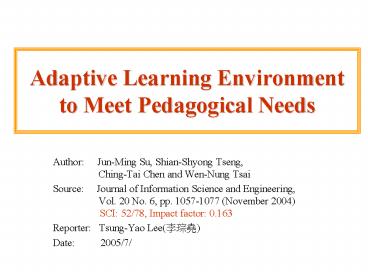Adaptive Learning Environment to Meet Pedagogical Needs - PowerPoint PPT Presentation
1 / 33
Title:
Adaptive Learning Environment to Meet Pedagogical Needs
Description:
Adaptive Learning Environment to Meet Pedagogical Needs. Author: Jun-Ming ... IAM = (ATset, Cset, Eset, E'set) 31. Definitions of related symbols in IAM 1. 32 ... – PowerPoint PPT presentation
Number of Views:112
Avg rating:3.0/5.0
Title: Adaptive Learning Environment to Meet Pedagogical Needs
1
Adaptive Learning Environment to Meet Pedagogical
Needs
- Author Jun-Ming Su, Shian-Shyong Tseng,
Ching-Tai Chen and Wen-Nung Tsai - Source Journal of Information Science and
Engineering, Vol. 20
No. 6, pp. 1057-1077 (November 2004) SCI
52/78, Impact factor 0.163 - Reporter Tsung-Yao Lee(???)
- Date 2005/7/
2
Outline
- Brief talking on SCORM 2004
- Introduction
- Instructional Activity Model (IAM)
- Pedagogical theories in IAM
- The construction of IAM
- Conclusion Comment
3
Brief talking on SCORM 2004
SCORM
pretest
content
posttest
Q1
Q2
Q3
Q4
Q5
Q6
CH1
CH2
U1
U2
U3
U4
U5
U6
SCORM 1.2
4
Introduction
- The Activity Tree (AT) is complex to manage and
reuse for a large-scale learning activity - Lack of inter-relations among Activity Tree
Scalability and flexibility of adaptive LMS are
limited
- SCORM only use grade and duration time to
evaluate learning result and sequence
These data may not be sufficient to evaluate the
personal learning behavior
5
Introduction (cont.)
- The proposed model IAM aims to generate an
adaptive learning course compatible to SCORM - Modularize large AT into several easy-managed and
reusable AT nodes with specific attributes and
inter-relations - Apply pedagogical theories for more adaptation
6
Instructional Activity Model
- IAM
7
A sample AT structure
Hard to Manage and Reuse
8
A diagram of IAM
9
Flowchart
10
Remedy course process
4. Select ATk with MAX( mReq(eij) grade(eki)
w(eki) )
3. Select suitable ci by 3 strategies
Easiest first Medium first Hardest first
2. Evaluate the value of (mReq(eij) - val(ci))
11
Case1.
AC (c1, 0.82), (c2, 0.75) and CO c4, c7,
c8.
I have ability c1 and c2 with value 0.82 and
0.75, respectively.
I need to have the capabilityc4, c7, c8
12
Case1.
AC (c1, 0.82), (c2, 0.75) and CO c4, c7,
c8.
SGPk ?i val(ci)w(eik)
13
Case2.
AC (c1, 0.82), (c2, 0.75) (c4, 0.75), (c5,
0.6), and CO c4, c8, c9.
C7
C9
1. AT5 has the largest value of cm lt CO
14
Case2.
AC (c1, 0.82), (c2, 0.75) (c4, 0.75), (c5,
0.6), and CO c4, c8, c9.
C7
C9
1. AT5 has the largest value of cm lt CO
2. Set SelectionPolicy Easiest First. c5 has
the smallest value 0.2 of (mReq(e55) - val(c5))
3. (mReq(e55)-grade(e'15)) w(e'15)) lt
(mReq(e25)-grade(e'25)) w(e'25)),
0.02 0.26
4. Deliver AT2 to learner.
15
Applying Pedagogical Theories in IAM
16
Extension scheme of IAM
Visual
Ci
Auditory
Kinesthetic
Capability
Learning style
17
Case3.
AC (vc1, 0.5), (cc2, 0.8), (mc3, 0.1), (vc4,
0.6), (ic5, 0.43) SLS lt0.1, 0.2, 0.7gt CO
ic5, vc6, mc7, ic8, cc9, ic10
I have the ability vc1, cc2, mc3, vc4, ic5
My learning style is Visual 0.1 Auditory
0.2 Kinetic 0.7
I need to know vc6, mc7, ic8, cc9, ic10
18
Case3.
AC (vc1, 0.5), (cc2, 0.8), (mc3, 0.1), (vc4,
0.6), (ic5, 0.43) SLS lt0.1, 0.2, 0.7gt CO
ic5, vc6, mc7, ic8, cc9, ic10
19
CO ic5, vc6, mc7, ic8, cc9, ic10
AT2 SGPk ?i val(ci)w(eik) 0.5 0.4
0.8 0.6 0.68 CF2 0.25 1 0.25 0.68
0.5 0.3 0.57 SF2 lt0.1, 0.2, 0.7gt?lt0.1,
0.8, 0.1gt 0.24
For challenging student AT2
For other student AT4
CFi 0.25 NOWi 0.25 SGPi 0.5
LgOrgi SFi SLS?LnStyi
20
The Construction of IAM
21
Step 1. Content-Contribution Relationship Table
22
Step2. weight matrix
The weight matrix of contribution B
The weight matrix of contribution C
23
Step3. Construction
24
Conclusion Comment
25
Conclusion
- propose the Instructional Activity Model
- propose an AT Selection algorithm with
Pedagogical Theory - proposed a systematic way to quickly and easily
construct IAM using traditional course resources
26
Comment
Fj the frequency function the user j uses the
AT Tj the time function the user j spends in the
AT Rj the retry function the user j uses the
AT Nj the score function the user j uses the
AT Uj the success and fail function the user j
uses the AT
YPChu, A Mathematical Model to Evaluate a CAI
Courseware, 1995
27
The Strategy of The Quantitative Measurement Rule
- For user
- Users reasoning ability
- Users answering ability
- Users learning achievement
- For courseware
- Development of the teaching element
- Fineness of the teaching element
- Effectiveness of the teaching element
- Difficulty level of the teaching element
28
(1) The guantitative measurement of the users
reasoning ability
(2) The quantitative measurement of the users
answering ability
29
Appendix
30
IAM (ATset, Cset, Eset, E'set)
31
Definitions of related symbols in IAM 1
32
Definitions of related symbols in IAM 2
33
Definitions for applying pedagogical theory in
IAM































